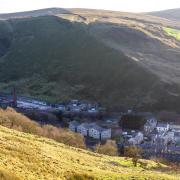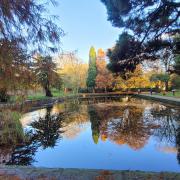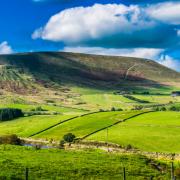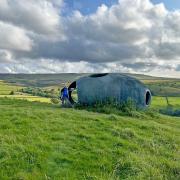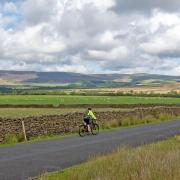Keith Carter leads a walk up Rivington Pike and enjoys some of the finest sights across wintry Lancashire

Rivington Pike has been visited by walkers for centuries, although it was not till the 19th century that people began to walk simply for exercise and enjoyment rather than as an unwelcome extra exertion getting to and from work. Imagine having to walk several miles in the morning and home again each night on top of a full working day.
These days there are many people who would not dream of walking a quarter of a mile to the shops. Dorothy Wordsworth in her diary writes of walking in to Ambleside from Dove Cottage, and back twice in one day, to see if there was any post for her brother William. They were made of sterner stuff in them days.
The use of the name Pike in regard to high points seems rather arbitrary. One thinks of Parlick Pike but Pendle Hill, the difference I suppose being that the summit rises to a point, but those Lakeland hills with pike in their name, (Rossett Pike, Cold Pike or Kentmere Pike) are not noticeably different from the fells surrounding them. I think it suggests a distinctly separate height with no similar one around it, but not always.
Rivington Pike is traditionally the scene of a fair on Good Friday when hundreds of folk congregate on the slopes for egg rolling and other fun, enjoying a day out with the family in the fresh air. You might say it is a celebration of the end of winter and the coming of spring.
The area is popular on most days of the year as well with Great House Barn being a Mecca for walkers, cyclists, bikers and motorists and a godsend for dog walkers to let their dog off the leash. The café does a roaring trade and the car park is usually quite full on the average day throughout the year. When full there is plenty of parking on the access road to Rivington Hall, now a venue for events such as weddings but originally the seat of a branch of the Pilkington family of Pilkington’s Glass fame.
The family crest depicts a man with a scythe, not the Grim Reaper as you may suppose but a reference to the time during the Norman Conquests when the then lord had to escape disguised as a mower.
The name Rivington is said to be Old English for ‘a farmstead at the rough or ragged hill although it may owe more to Rowenton, the place of the Rowan or Mountain Ash tree. Like all place names, different interpretations are given. Our walk can be done at any time of year but if there is snow on the ground we are greeted by Alpine scenery as we leave the car park at Great House Barn, cross the road and head up the straight avenue of beech trees towards the hall.
Keep to the right of the front of the hall, pass the entrance to Rivington Barn and take the path to the right behind it, then look for a footpath on the left. A rising path goes through a gate and we stay with it through a hairpin bend beyond which a further path is apparent on the left. The path climbs quite steeply but is recently restored and makes easy going up to where it joins a broader track. Turn right here and at the next fork keep left.
We come to a brick bridge across the track and speculate on what its use might have been. It has one large arch and six smaller ones which accounts for the name Seven Arches Bridge. The estate was created by William Lever, the first Baron Leverhulme, the philanthropist and inspirational industrialist who had his designers incorporate gazebos, follies and pagodas into the gardens to enhance the view. The bridge was ornamental.
After passing two large cylindrical gateposts either side of the track we notice a flight of steps on the left mounting to an archway. Beyond the arch is a broad overgrown area which was once Lord Leverhulme’s private garden but is now a wasteland, then a further flight of steps brings us onto a further prominent track. Turn right and the tower atop the pike comes into view.
At a stone building look for a kissing gate on the left and join a stony track heading towards the pike, then a path that climbs up the fairly steep conical side to reach the tower. Lord Leverhulme’s shooting parties used it for taking their luncheon with, I imagine, large quantities of fine wine and brandy. You can learn a lot from Downton Abbey.
You can’t go in or up the tower, it’s all bricked up and you are left with the view, the fun being in identifying the salient points in all directions except east where Winter Hill crowds the vista.
Leave the pike for your return journey heading due south, that is in the direction of the Reebok Stadium, if you can see it. After a sharpish descent the path levels out and brings us to a meeting of ways. Cross a wide track to a bridleway opposite and head downhill, soon to reach a lane at a right-angle bend where we keep forward and stay on the lane until we see a wide ride striking off to the right.
This wooded ride is dead straight, other paths joining it in places but we keep straight on until we come to a fork. Keep left then left again and we find ourselves back on the avenue that connects the Great House Barn to the hall. In a matter of a few hundred yards we are back at the barn ready for a bun and a brew.
Compass points
Area of walk: Rivington
Map: OS Explorer 287 West Pennine Moors
Walk: To Rivington Pike and back
Distance: 5 miles
Time to allow: 2½ hours
Refreshments and toilets at Great House Barn Tea Room, open daily 10am, 01204 697738.




